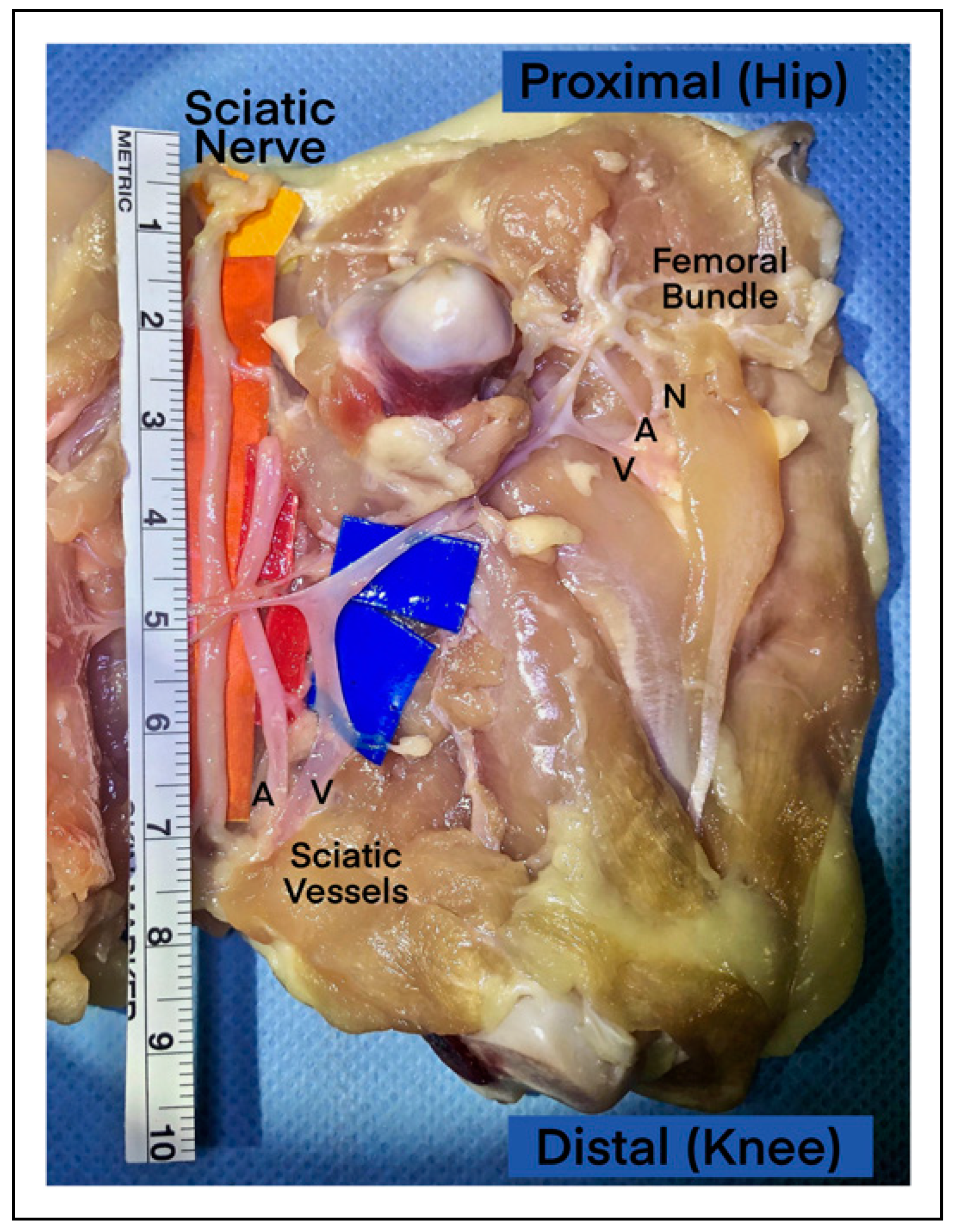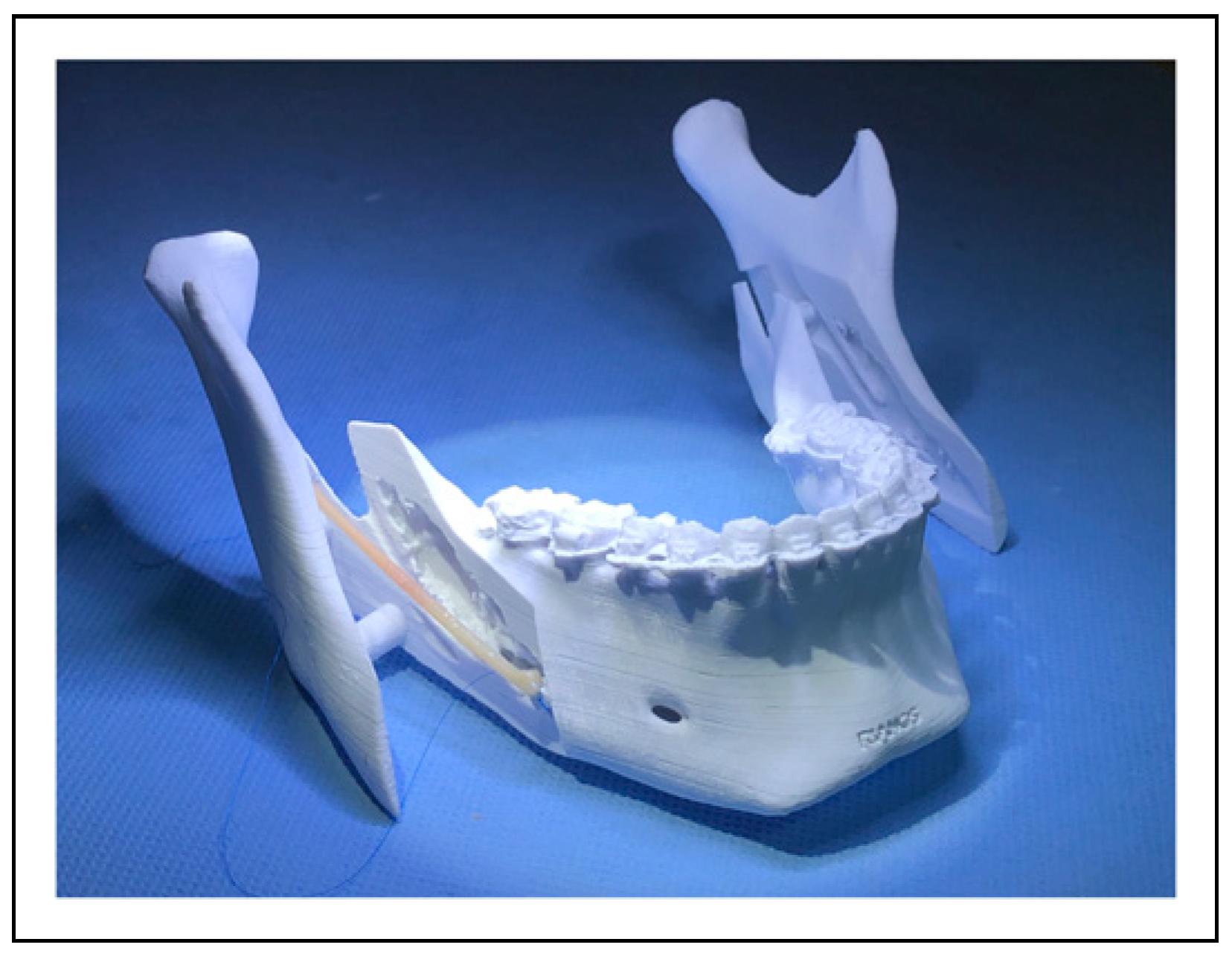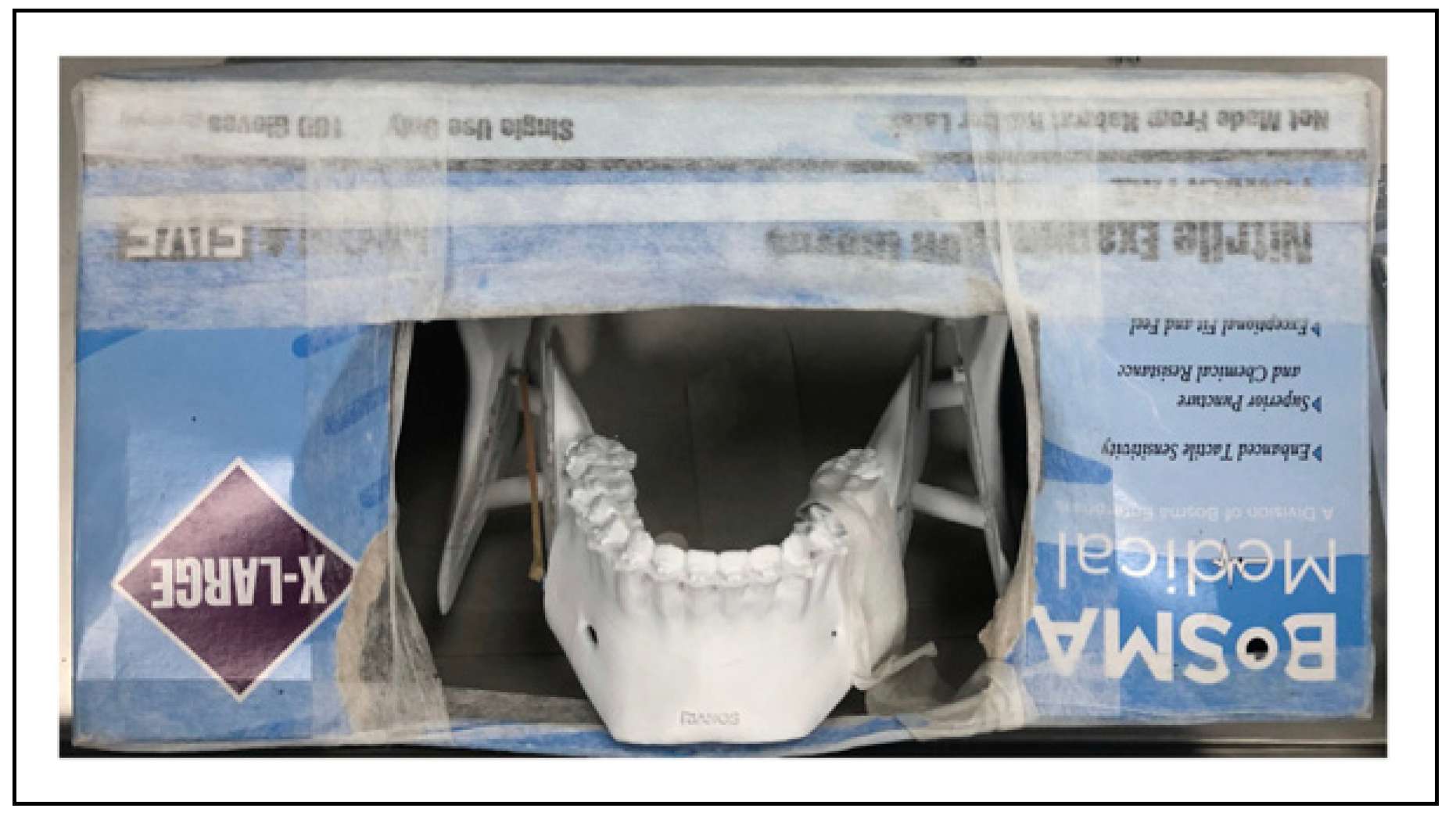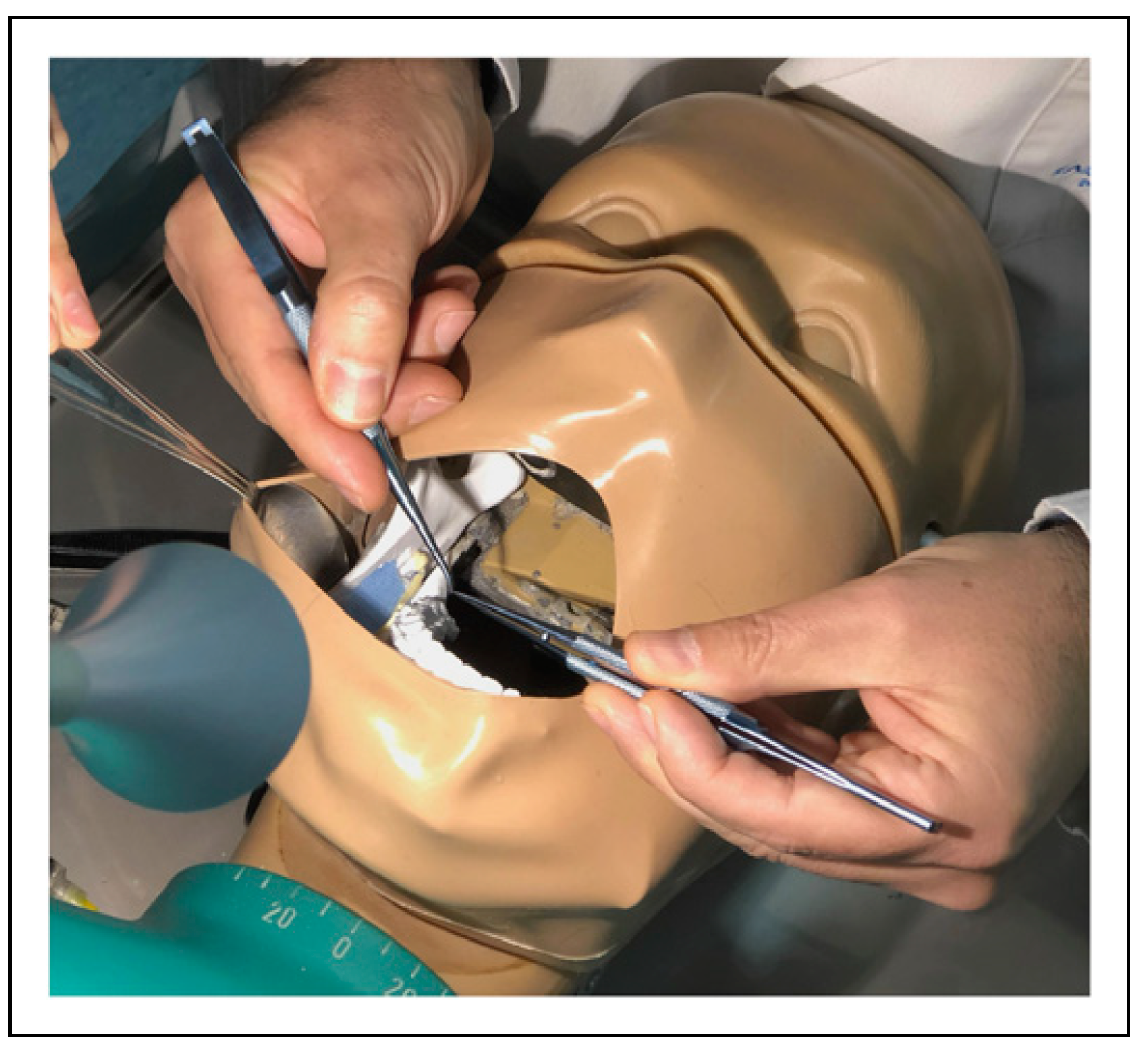Repair of Inferior Alveolar Nerve in Orthognathic Surgery Simulator (RIANOS): A Novel, Open-Source, Combined 3D Printed, and Ex-Vivo Chicken Sciatic Nerve Training Model
Abstract
Introduction
Materials and Methods
Model Design
Evaluation: Face and Content Validity
Results
Model Development
Face and Content Validation: Survey Results
Discussion
Conclusions
Funding
Supplemental Material
Acknowledgments
Conflicts of Interest
References
- Steinhäuser, EW. Historical development of orthognathic surgery. J Craniomaxillofac Surg. 1996, 24, 195–204. [Google Scholar] [CrossRef] [PubMed]
- Hausamen J-E. The scientific development of maxillofacial surgery in the 20th century and an outlook into the future. Journal of Cranio-Maxillofacial Surgery. 2001, 29, 2–21. [Google Scholar] [CrossRef]
- Obwegeser HL Orthognathic surgery and a tale of how three procedures came to Be: a letter to the next generations of surgeons. Clinics in Plastic Surgery. 2007, 34, 331–355. [CrossRef] [PubMed]
- Levine MH, Goddard AL, Dodson TB. Inferior alveolar nerve canal position: a clinical and radiographic study. J Oral Maxillofac Surg. 2007, 65, 470–474. [Google Scholar] [CrossRef]
- Al-Siweedi SYA, Nambiar P, Shanmuhasuntharam P, Ngeow WC. Gaining surgical access for repositioning the inferior alveolar neurovascular bundle. The Scientific World Journal. 2014, 2014, 719243. [Google Scholar] [CrossRef]
- D’Agostino A, Trevisiol L, Gugole F, Bond´ı V, Nocini PF. Complications of orthognathic surgery: the inferior alveolar nerve. J Craniofac Surg. 2010, 21, 1189–1195. [Google Scholar] [CrossRef]
- Panula K, Finne K, Oikarinen K. Incidence of complications and problems related to orthognathic surgery: a review of 655 patients. J Oral Maxillofac Surg. 2001, 59, 1128–1136. [Google Scholar] [CrossRef]
- Choi B-K, Lee W, Lo L-J, Yang E-J. Is injury to the inferior alveolar nerve still common during orthognathic surgery? Manual twist technique for sagittal split ramus osteotomy. Br J Oral Maxillofac Surg. 2018, 56, 946–951. [Google Scholar] [CrossRef]
- Teltzrow T, Kramer F-J, Schulze A, Baethge C, Brachvogel P. Perioperative complications following sagittal split osteotomy of the mandible. J Craniomaxillofac Surg. 2005, 33, 307–313. [Google Scholar] [CrossRef]
- Tay ABG, Poon CY, Teh LY. Immediate repair of transected inferior alveolar nerves in sagittal split osteotomies. J Oral Maxillofac Surg. 2008, 66, 2476–2481. [Google Scholar] [CrossRef]
- Allouni A, Dunne J, Collin T, Saleh D. A survey of micro-surgery training among UK plastic surgery and maxillofacial surgery trainees. Microsurgery. 2014, 34, 419–420. [Google Scholar] [CrossRef]
- Rodriguez JR, Yañez R, Cifuentes I, Varas J, Dagnino B. Microsurgery workout: a novel simulation training curricu-lum based on nonliving models. Plast Reconstr Surg. 2016, 138, 739e–747e. [Google Scholar] [CrossRef]
- Odobescu A, Dawson D, Goodwin I, Harris PG, BouMerhi J, Danino MA. High-fidelity microsurgical simulation: the Thiel cadaveric nerve model and evaluation instrument. Plast Surg (Oakv). 2019, 27, 289–296. [Google Scholar] [CrossRef]
- Safi A-F, Safi S, Timmer M, Goldbrunner R, Kauke M. Epineurial nerve coaptation: a biological nonliving training model using gradually thawed cryopreserved sciatic nerves. J Craniofac Surg. 2018, 29, e708–e712. [Google Scholar] [CrossRef]
- Jeong H-S, Moon M-S, Kim H-S, Lee H-K, Yi S-Y. Microsurgical training with fresh chicken legs. Ann Plast Surg. 2013, 70, 57–61. [Google Scholar] [CrossRef]
- Couceiro J, Castro R, Tien H, Ozyurekoglu T. Step by step: microsurgical training method combining two nonliving animal models. J Vis Exp 2015, e52625. [CrossRef]
- Gul BU, Yanilmaz DK, Arslan D, Bayramicli M, Akbulut O. Silicone-based simulation models for peripheral nerve microsurgery. J Plast Reconstr Aesthetic Surg. 2019, 72, 477–483. [Google Scholar] [CrossRef]
- Javid P, Aydın A, Mohanna P-N, Dasgupta P, Ahmed K. Current status of simulation and training models in microsurgery: a systematic review. Microsurgery. 2019, 39, 655–668. [Google Scholar] [CrossRef]
- Svane TJ, Wolford LM, Milam SB, Bass RK. Fascicular characteristics of the human inferior alveolar nerve. J Oral Maxillofac Surg. 1986, 44, 431–434. [Google Scholar] [CrossRef]
- Ikeda K, Ho KC, Nowicki BH, Haughton VM. Multiplanar MR and anatomic study of the mandibular canal. AJNR Am J Neuroradiol. 1996, 17, 579–584. [Google Scholar]
- Gargallo JU, Rubio EA, Pe´rez JLG, Lagares DT, Va´zquez CC. New dental simulator for microsurgical training preliminary overview. Med Oral Patol Oral Cir Bucal. 2007, 12, E582–E584. [Google Scholar]




| Strongly | Strongly | ||||
|---|---|---|---|---|---|
| Statement \ Answers (N = 12) | Disagree | Disagree | Neutral | Agree | Agree |
| Face Validity | |||||
| 1) Does the appearance and manipulation of the chicken sciatic nerve properly simulate the IAN? | 0 (0%) | 0 (0%) | 0 (0%) | 1 (8.3%) | 11 (91.7%) |
| 2) Does the visual appearance of the mandible with its bilateral sagittal split osteotomies look realistic? | 0 (0%) | 0 (0%) | 0 (0%) | 4 (33.3%) | 8 (66.7%) |
| 3) Does the box of gloves properly simulate the depthness and shape of the human mouth? | 0 (0%) | 1 (8.3%) | 2 (16.7%) | 5 (41.7%) | 4 (33.3%) |
| 4) Does the face phantom properly simulate the depthness and shape of a human mouth? | 0 (0%) | 0 (0%) | 0 (0%) | 2 (16.7%) | 10 (83.3%) |
| 5) Did you prefer practicing intraoral microsurgical techniques using loupes? | 0 (0%) | 0 (0%) | 4 (33.3%) | 4 (33.3%) | 4 (33.3%) |
| 6) Did you prefer practicing intraoral microsurgical techniques using the optic microscope? | 0 (0%) | 2 (16.7%) | 0 (0%) | 3 (25%) | 7 (58.3%) |
| Content Validity | |||||
| 7) Does RIANOS achieve overall realism for practicing intraoral microsurgical techniques compared to training in a flat surface? | 0 (0%) | 0 (0%) | 0 (0%) | 2 (16.7%) | 10 (83.3%) |
| 8) Is RIANOS a useful tool for residents to learn nerve repair of the IAN during orthognathic surgery? | 0 (0%) | 0 (0%) | 0 (0%) | 0 (0%) | 12 (100%) |
| 9) Is RIANOS a useful tool for training surgeons with previous orthognathic surgery and nerve repair experience? | 0 (0%) | 0 (0%) | 0 (0%) | 1 (8.3%) | 11 (91.7%) |
| 10) Would you consider implementing RIANOS as a training model for plastic surgery and/or maxillofacial surgery residents? | 0 (0%) | 0 (0%) | 0 (0%) | 0 (0%) | 12 (100%) |
© 2024 by the authors. Published by MDPI on behalf of the AO Foundation. Licensee MDPI, Basel, Switzerland. This article is an open access article distributed under the terms and conditions of the Creative Commons Attribution (CC BY) license (https://creativecommons.org/licenses/by/4.0/).
Share and Cite
Navia, A.; Tapia, S.; Rojas, M.F.; Rojas, F.; Vargas, A.; Guerra, C.; Cuadra, A.; Searle, S.; Ramírez, H.; Teuber, C. Repair of Inferior Alveolar Nerve in Orthognathic Surgery Simulator (RIANOS): A Novel, Open-Source, Combined 3D Printed, and Ex-Vivo Chicken Sciatic Nerve Training Model. Craniomaxillofac. Trauma Reconstr. 2024, 17, 43. https://doi.org/10.1177/19433875241236322
Navia A, Tapia S, Rojas MF, Rojas F, Vargas A, Guerra C, Cuadra A, Searle S, Ramírez H, Teuber C. Repair of Inferior Alveolar Nerve in Orthognathic Surgery Simulator (RIANOS): A Novel, Open-Source, Combined 3D Printed, and Ex-Vivo Chicken Sciatic Nerve Training Model. Craniomaxillofacial Trauma & Reconstruction. 2024; 17(4):43. https://doi.org/10.1177/19433875241236322
Chicago/Turabian StyleNavia, Alfonso, Sebastian Tapia, Maria Fernanda Rojas, Francisco Rojas, Alex Vargas, Claudio Guerra, Alvaro Cuadra, Susana Searle, Hernan Ramírez, and Cristian Teuber. 2024. "Repair of Inferior Alveolar Nerve in Orthognathic Surgery Simulator (RIANOS): A Novel, Open-Source, Combined 3D Printed, and Ex-Vivo Chicken Sciatic Nerve Training Model" Craniomaxillofacial Trauma & Reconstruction 17, no. 4: 43. https://doi.org/10.1177/19433875241236322
APA StyleNavia, A., Tapia, S., Rojas, M. F., Rojas, F., Vargas, A., Guerra, C., Cuadra, A., Searle, S., Ramírez, H., & Teuber, C. (2024). Repair of Inferior Alveolar Nerve in Orthognathic Surgery Simulator (RIANOS): A Novel, Open-Source, Combined 3D Printed, and Ex-Vivo Chicken Sciatic Nerve Training Model. Craniomaxillofacial Trauma & Reconstruction, 17(4), 43. https://doi.org/10.1177/19433875241236322




